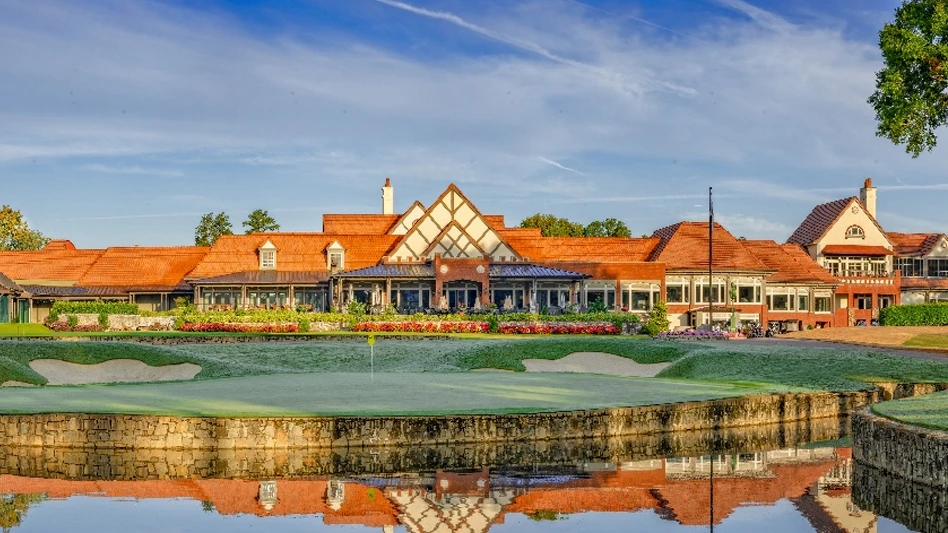
Pinehurst No. 2 hums with activity in late May as superintendent John Jeffreys walks a four-hole loop on the famed course he manages. After returning to his utility vehicle, Jeffreys travels opposite play along the second hole.
Jeffreys spots a quartet of employees working in native areas. Two are driving carts; two are carrying backpacks. “There go our rough mowers,” Jeffreys tells a visitor.
Selective spraying replaced mowing turf in 35 acres following a Bill Coore- and Ben Crenshaw-led project started in 2010 and completed in 2011. The design and maintenance of Pinehurst No. 2’s native areas offers the industry an evolving case study of what happens when turf goes away.
Superintendents and architects are frequently seeking guidance from members of the Pinehurst team on how to handle the aftermath of a turf removal. In a move designed to further understand their own project, architect Jason Straka and members of the team involved in the turf removal at Los Robles Greens in Thousand Oaks, Calif., (page 12)visited Pinehurst to learn from the experiences of Jeffreys and director of golf course and grounds management Bob Farren. “One of the things that I truly wanted to learn was how they manage it, how they maintain it and what impacts and decisions we were going to be making from the design side of things had on maintenance and playability,” Straka says.
Thousand Oaks and Arcis Golf officials had agreed on reinventing Los Robles before the trip, but Pinehurst No. 2 served as an example of the looming changes for Los Robles customers. Infoboards, including one describing the changes at Pinehurst, were placed in prominent areas of the pro shop. “It gave us confidence,” Arcis Golf vice president of construction Ed Easley says. “They were in their fourth year into it, which is hugely important because they were at that point we knew we needed to get.”

The fourth year of less turf at Pinehurst No. 2 didn’t resemble the first, second or third years, according to Farren and Jeffreys. And the fifth year didn’t resemble the fourth. “There are so many variables with the golf course, whether it’s the weed pressure or undesirable plant pressure in the native areas,” says Jeffreys, who was promoted to superintendent after the resort named Kevin Robinson golf course maintenance manager in fall 2014. “It’s an ever-changing thing.”
If there’s such a thing as normal for the revamped Pinehurst No. 2, then the crew experienced it last summer. The majority of the maintenance efforts following the restoration focused on preparing the course for hosting the 2014 U.S. men’s and women’s opens. A conversion from bentgrass to Champion Bermudagrass greens followed the women’s open. The summer of 2015 proved wet, and Farren says they learned “it can go two days without rain and we are great, and then it could rain for two days and stuff is popping up everywhere.”
Jeffreys calls learning how to manage native areas “a thorough process.” Pinehurst gives employees a yardage-book sized guide to plants and weeds they might encounter while working on the course. Experienced workers guide newcomers through the native areas. After observing test plots in fall 2014 and spring 2015, a pre-emergent spray program was implemented for the first time this year and it has shown positive results controlling crabgrass and goosegrass, Jeffreys says.
The changes at Pinehurst No. 2 stemmed from ownership’s decision to return to the original Donald Ross look, and Farren says the USGA made “a lot bigger deal” out of the water conservation angle than anybody at the resort expected. “Come U.S. Open I was overwhelmed with the amount of conversations they wanted to have about water,” he adds.
Quantifying water savings related to the restoration is tricky, because Pinehurst lacked specific numbers about its water usage before 2010 and irrigation records also include data about usage at the resort and landscaping within the village. Annual rainfall totals in Pinehurst can experience sharp fluctuations. Farren, Jeffreys and Robinson are gracious with their time, and they urge colleagues and other industry figures perils are attached to emulating Pinehurst’s turf removal.
“Bill Coore said it best,” Jeffreys says. “He said, ‘John, there’s no textbook on these things. You have to learn as you go. You will be able to pass information along and share what your mistakes have been and what your successes have been.’ That would be the first thing I would tell somebody – there is no textbook. There are going to be things you are going to learn.”
History is another separator between Pinehurst No. 2 and other courses. How many courses rest across the street from where Ross lived? Pinehurst No. 2’s native areas also receive little cart traffic because of the widespread use of caddies, an often overlooked separator.
Still, as long as operators see value in removing turf, anecdotes from Pinehurst No. 2 will be used in places such as Thousand Oaks, Calif. “Very seldom does a week go by that we don’t reflect on ’14 and certainly the restoration,” Farren says. “It still has legs as far as people having an interest in it.”

Explore the July 2016 Issue
Check out more from this issue and find your next story to read.
Latest from Golf Course Industry
- PBI-Gordon Company hires marketing manager Jared Hoyle
- Mountain Sky Guest Ranch announces bunker enhancement project
- GCSAA names Joshua Tapp director of environmental programs
- AQUA-AID Solutions bolsters Sunshine State presence
- Escalante Golf acquires secluded Illinois course
- Tartan Talks 105: Nathan Crace and Todd Quitno
- Disease Discussion 24: Let the turf talk to you
- From the publisher’s pen: Foggy intrigue





